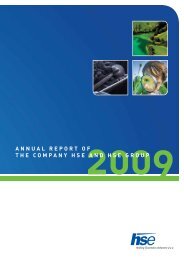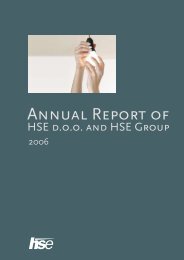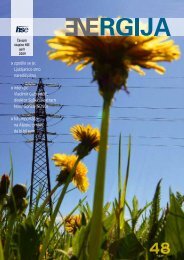ANNUAL REPORT - HSE
ANNUAL REPORT - HSE
ANNUAL REPORT - HSE
Create successful ePaper yourself
Turn your PDF publications into a flip-book with our unique Google optimized e-Paper software.
folios. In addition, the scope of stress testing was expanded<br />
in 2008. Stress testing is a risk management<br />
tool which is used in particular to analyse a potential<br />
negative impact of an extreme change in the value of<br />
a variable or a group of variables on the company’s<br />
operations.<br />
In the previous year, price risks were also controlled<br />
by means of hedging a large share of the trading volume<br />
by a counter-transaction, by purchasing derivatives<br />
and by introducing new technologies, which were<br />
adopted as part of the development plan of the <strong>HSE</strong><br />
Group and outline measures for improving environment<br />
protection and people's health.<br />
• in periods of increased TPP production, economic<br />
limitations or any changes in the overall method<br />
of CO 2<br />
tax payments and in trading in CO 2<br />
emission<br />
coupons should also be considered.<br />
In 2008 the production at hydropower plants within the<br />
<strong>HSE</strong> Group was 375 GWh higher than planned, whereas<br />
at TEŠ the plan was exceeded by 158 GWh and at<br />
TET by 21 GWh. The deviations of actual daily flow of<br />
water from daily forecasts are also reflected in deviations<br />
of hydropower production from the forecasted<br />
schedules. To the extent possible, the deviations were<br />
balanced out by adjusting production at TPP and by<br />
increasing sales and purchases.<br />
<strong>ANNUAL</strong> <strong>REPORT</strong> <strong>HSE</strong> | BUSINESS <strong>REPORT</strong><br />
78<br />
Quantity risks<br />
Quantity risk comprises the risks arising from production<br />
uncertainty, consumption uncertainty and energy<br />
supply uncertainty.<br />
Production uncertainty is mainly associated with the<br />
question whether energy will be available on the market.<br />
It is also linked to operational risk, which aims to<br />
assess the probability and effect of a turbine or any other<br />
production unit failing. Particularly important is the<br />
impact of uncertain hydrology because a large share of<br />
electricity is supplied from hydropower plants.<br />
Consumption uncertainty arises from the impact of<br />
weather and temperature, load flexibility, seasonal<br />
cycles and impact of the recession.<br />
Energy supply uncertainty arises from random failures<br />
of power lines and other equipment, or from<br />
interventions by the power transmission network operator<br />
due to transmission line overload.<br />
Electricity production is exposed to the following risks<br />
of deviation from the planned supply:<br />
• the risk of non-supply of electricity from hydropower<br />
plants due to hydrological and meteorological conditions;<br />
• the risk of non-supply of electricity from thermal<br />
power plants due to outages or technological and<br />
ecological limitations of production;<br />
• the risk of non-supply of coal from the Velenje coal<br />
mine due to production hold-ups caused by outages,<br />
failures of technological systems, accidents or other<br />
disturbances;<br />
At the thermal power plants, a 2 to 4% unexpected<br />
production outage has to be considered in addition to<br />
the planned shutdowns due to overhauls. This percentage<br />
corresponds to ten to twelve daily production<br />
outages, which can be offset by starting up gas-fired<br />
power plants, but only for short periods. Alternatively,<br />
to the extent possible, outages can be offset by reallocating<br />
the use of HPP accumulation and purchasing<br />
electricity on the market. In 2008 TEŠ's unexpected<br />
production outage stood at 1%. This unfavourable outcome<br />
is primarily the result of Unit 3 breaking down.<br />
TET's outage rate stood at 2.4%.<br />
Thanks to a less complex production process, HPPs<br />
are more reliable. The unexpected production outage<br />
at DEM stood at 1.2%, at SENG at 2.4% and at HPP<br />
Boštanj at 33.8%, in the latter case mainly due to the<br />
failure of generator 2.<br />
Coal supply may be interrupted due to breakdowns of<br />
technological systems and accidents or other disturbances<br />
affecting the extraction of coal. According to an<br />
assessment of the coal mine’s technical management,<br />
the majority of potential outages could be remedied<br />
without significant production interruptions, and rarely<br />
would such breakdowns result in 14 to 20 days of<br />
interrupted supply. There is relatively low probability<br />
of a major breakdown that would require a six-month<br />
shutdown. Based on the above assessment, minimum<br />
joint coal stocks of the <strong>HSE</strong> Group have been determined.<br />
They stand at 3,000 TJ (February–October) and<br />
4,000 TJ (November–January).<br />
The <strong>HSE</strong> Group's electricity production is managed<br />
from the control centre in Maribor. The main objectives<br />
of production management are as follows:
















